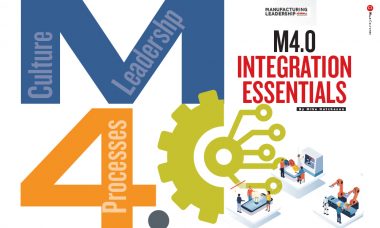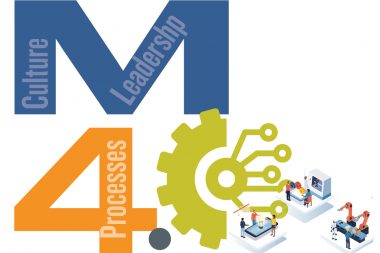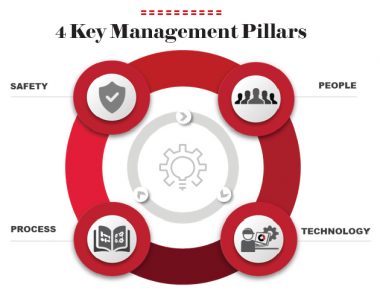M4.0 Integration Essentials

It takes a meaningful alignment of culture, leadership, and processes to power effective M4.0 business operations. By Mike Hutcheson

For operations and maintenance in a Manufacturing 4.0 environment, dependency on heroic individuals and ad hoc work processes is a recipe for failure. Process and discrete manufacturers, bound by unforgiving production schedules and constrained budgets, require unified, meaningful efforts to achieve predictable safety, uptime, throughput, and costs.
Integrated business operating systems deliver mission unity and process consistency for digitally transformed (and transforming) organizations. Rather than relying on a set of routine business processes performed by rote, an integrated system blends three core essentials to ensure that everyone feels valued and is fully engaged, optimized, and delivering meaningful value. These essentials include:
- Leadership values
- Process dependency
- Cultural alignment
Aside from advantages in operational efficiency and performance metrics, businesses with successful operating system integration have the speed and agility to meet dynamic market forces and deliver new opportunities for sustained competitiveness.
Furthermore, establishing a cohesive relationship between the core essentials empowers companies to continuously improve their M4.0 culture at the site level, across the broader organization, and even among trusted partners and customers. Read on to learn why this structure is important, what makes it unique, and how to successfully achieve it.
Manufacturing Evolution Starts With a Platform
The shift in manufacturing roles, responsibilities, and priorities, and the quick deployment of advanced technologies, makes the transition from person dependency to process dependency more vital than ever. For the manufacturer, losing an exceptional maintenance technician can mean a spike in downtime and production losses. For the maintenance service provider, losing an exceptional site manager can mean losing the account. Counting on individuals or functional teams to be the “hero of the day” creates excessive and unnecessary pressure on the organization.

“By taking impactful action to make a routine task meaningful, the teams are actively improving safety, and the ROI in improving people’s safety is priceless.”
Implementing a business operating system, much like a computer operating system, provides the foundational structure and standards required for optimal business functioning. Top-tier business operating systems consist of best-in-class tools, processes, practices, and standards for how operational teams conduct themselves and continuously improve. Cultural alignment, leadership values, and process dependency are tightly intertwined, driving ongoing positive change in the corporate culture.
This is important because like a three-legged stool, any deficiency in the trio of operating system essentials means the unit will not function as intended. Excellent business processes alone, or leadership alone, will provide a fraction of the desired return on investment. But when leadership values and process dependency are combined and aligned in the corporate culture, the overall impact of the operating system can reach 90-95% ROI or higher.
A similar concept is the train, apply, and teach philosophy for learning – another three-legged stool. One who is trained on a concept but never uses it might retain 5-7% of the information. When the learning is applied, the retention rate increases. Teach it to others and the knowledge is locked in. This philosophy, when incorporated in integrated business operating systems, reinforces and improves team development.

“When leadership values and process dependency are combined and aligned in the corporate culture, the overall impact of the operating system can reach 90-95% ROI or higher.”
Core Essentials Drive Results
While leadership values come from the top down, meaningful processes provide the underlying direction. Together they help to improve the company culture and ensure alignment with its goals and specifications.
Leadership values
At a high level, leadership is about upholding a common set of values and beliefs. Leaders coach and develop teams and encourage them to become proficient and autonomous. They are expected to be good listeners, have empathy, be great communicators, know their audience, and know how to approach coaching. They also hold people accountable while allowing them to fail. By employing these core leadership values, they build organizational trust, which in turn provides a path to cultural alignment.
Process dependency
Processes provide direction and eliminate erratic and unpredictable behavior. Sites or plants that are unorganized and lack user processes, goals, action plans, and visual performance monitoring tools can achieve process dependency by establishing standards that become central to employee training and development, allowing them to become more engaged, effective, and confident in their work.
Importantly, processes must be meaningful, not mechanical, to achieve the maximum benefit. Treating processes as if they are checklists of actions to be taken is mechanical and brings limited value to the organization. Meaningful processes, on the other hand, are a product of teams thinking harder, asking probing questions, and using the operating system and its tools to take consequential actions, thus delivering added value.
Consider the different outcomes of a Tier 1 meeting that employs mechanical vs. meaningful processes. When sub-standard safety performance is acknowledged, does the team move on to the next topic or does it discuss the situation and agree to put an action on the board to do a 5Y at the next meeting? After reading a Toolbox Talk on the hazards of wooden ladders, does the team move on to the next topic, or reflect on why these ladders are dangerous and create an action to locate all wooden ladders in the plant and red-tag them so they can be replaced?

With integrated operating systems, leaders use the process to align the culture and create meaningful change. By taking impactful action to make a routine task meaningful, the teams are actively improving safety, and the ROI in improving people’s safety is priceless. Spreading the knowledge by sharing their findings with other sites to improve their culture provides an additional path to cultural alignment.
Cultural alignment
Establishing trust and a growing comfort level within a team builds confidence that they are being heard by leadership and their opinions matter. With this confidence, they become more autonomous and self-directed, and begin to proactively drive process maturity.
This culture change and its advantages are reciprocal. As leaders become more confident in their teams and give them more independence, they can then shift more toward driving customer satisfaction, growing the business, and thinking outside the box.
Furthermore, cultural alignment inspires customers and partners who are more reactive and unstructured to raise the bar internally. For instance, maintenance service providers set a positive example for their customers by demonstrating the value of cultural alignment, effective leadership, and process consistency on maintenance outcomes. This encourages the customer’s own teams to strive for a more organized, prioritized, planned, and systematic approach to maintenance, facilitating a stronger and more direct connection between the two organizations. The effects of this alignment also carry over to the operational teams as the flow of product in the plant improves.
On the flip side are relationships where both parties already have robust business operating systems and strong cultural commitment. Organizations in such a mature state appreciate companies with a similar mindset and become more strongly connected.
Progressing Toward a Winning Team
Operating system training is an evolutionary process best described in progressive phases of completion, such as Bronze, Silver, and Gold:
- Bronze-phase teams have been trained on all the critical elements of the operating system, are beginning to use them, and understand why they are using them, but the processes are not fully meaningful yet. There are no performance metrics at this point.
- Silver-stage teams are using the processes, taking impactful actions, and elements of team ownership and autonomy are visible — such as site managers no longer running Tier 1 meetings but instead observing and coaching from the back of the group. These teams also have fairly strict performance criteria to ensure their processes are driving performance improvements and the operating system is providing value.
- Gold represents the height of maturity. Gold teams actively use the processes and leadership components to really adjust and align the culture. Technicians independently initiate and conduct root cause analyses, and proactively initiate process improvements without coaching. Tier 1 meetings are conducted in a very autonomous manner, and the site manager may invite the customer or partner to the meeting to discuss afterward what can be done to further improve and grow the business. Gold performance criteria is also more stringent. The teams become mentors to other sites, and they may even become involved in the company’s strategy. Because they have reached a mature state, they are no longer being reactive and have more time to test new strategic initiatives in real time to see how they would work in the real world.

“Processes must be meaningful, not mechanical, to achieve the maximum benefit.”
Develop an Effective Messaging Strategy
The way to achieve buy-in for an integrated business operating systemis through effective messaging and solid results. Summing up an operating system in categories, or pillars, simplifies the concept so it is easier to digest, while also reflecting holistically how the business is driven.
For example, Safety, People, Process, and Technology (SPPT) are our four key management pillars. SPPT reflects our business priorities, with safety always #1. Under each pillar is a defined set of critical elements, and under each critical element is a standard set of activities, tools, templates, and training.
This helps to align the strategy and ensure all sites operate in a very consistent fashion. It also starts to streamline the organization by increasing connectivity and eliminating silos. The more silos that can be removed, the more open the communication, and the more fluid the processes.
No matter what pillars are chosen to portray the operating system, without the integration of cultural alignment, leadership values, and meaningful processes providing direction, the results will not be nearly as impressive or exciting as they otherwise could be.